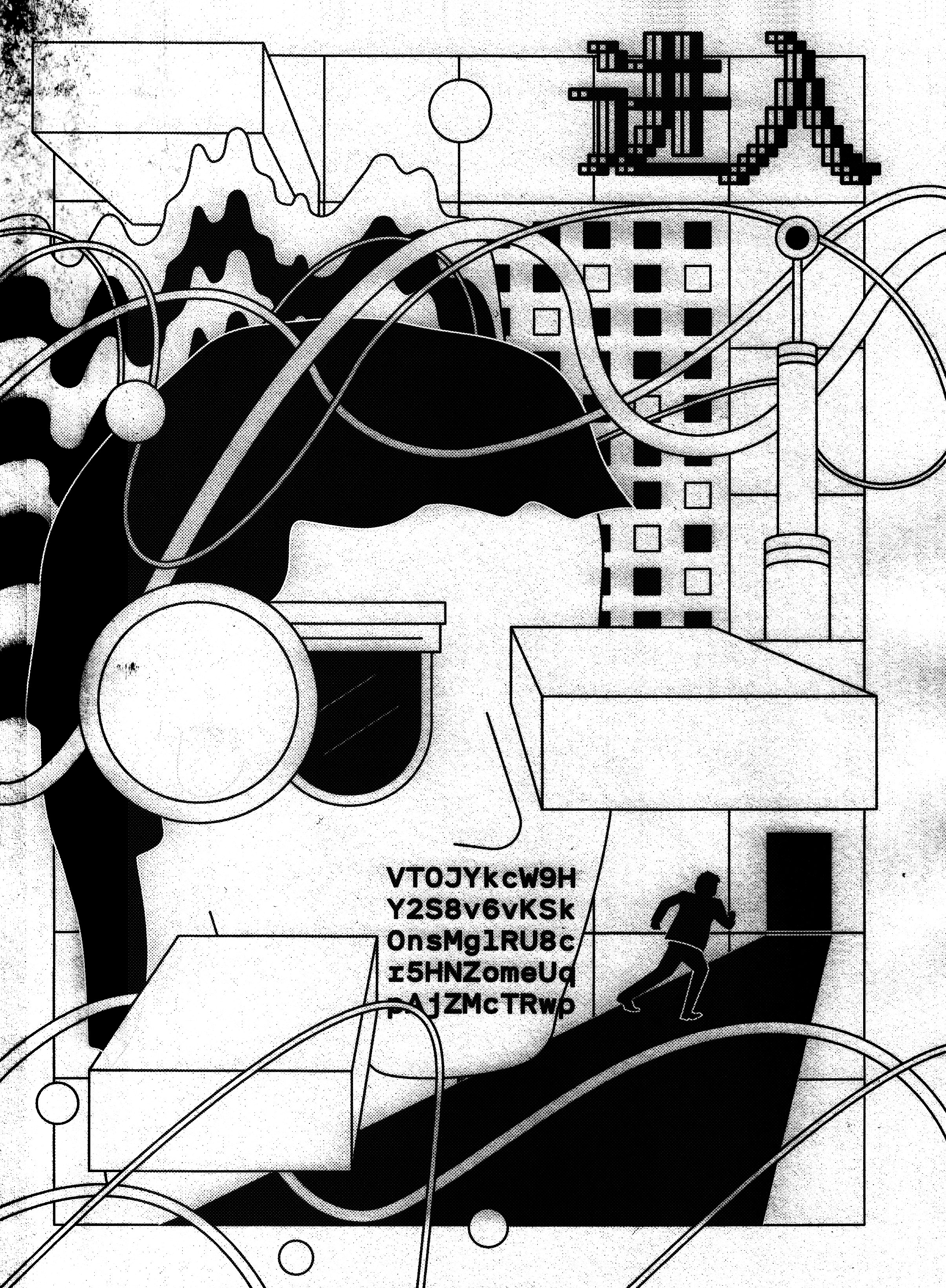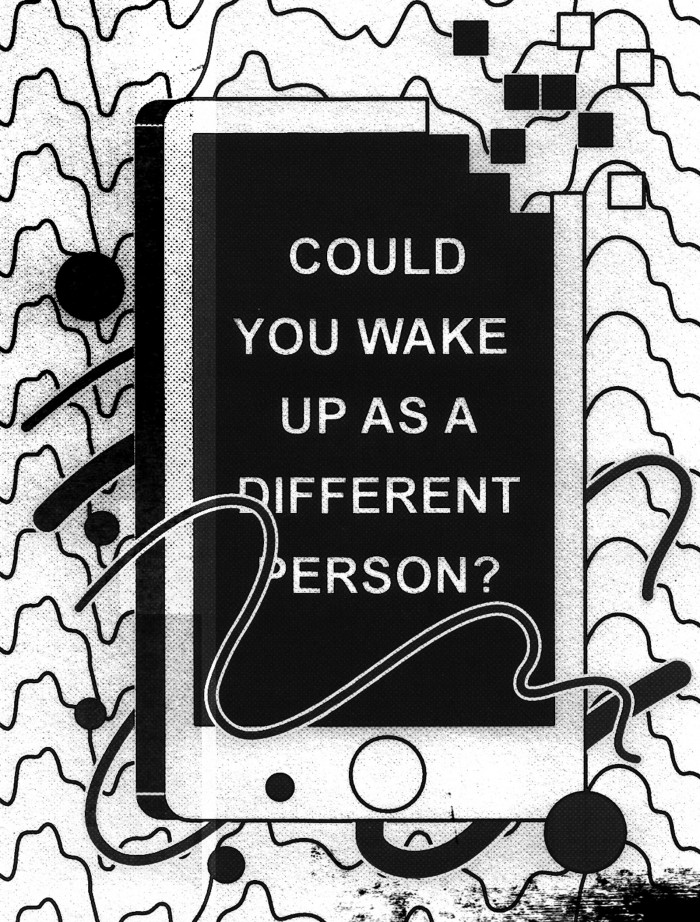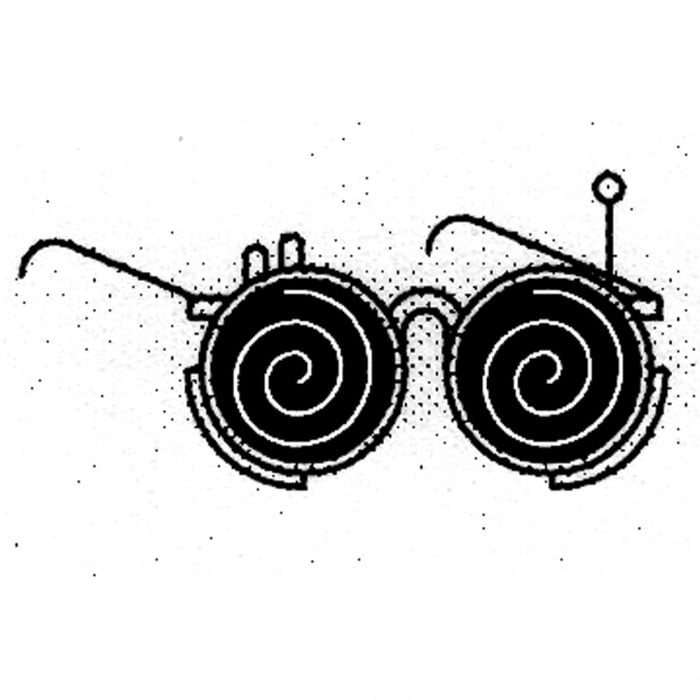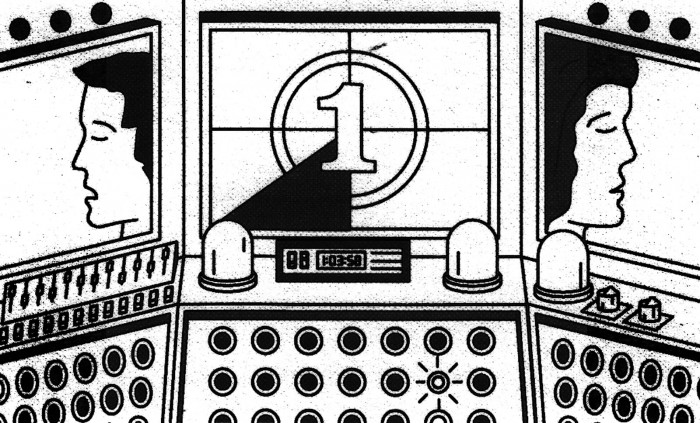The Reunion: a new science-fiction story about surveillance in China

Though only 23 minutes on the high-speed rail from Shenzhen North to West Kowloon, the journey from the mainland to Hong Kong seems to transport me back half a century. The concrete jungle of my childhood memories hasn’t changed one bit. Time seems trapped in the amber of this city of seven million, while the Shenzhen Bay area that I departed has already arrived at the future ahead of schedule.
My classmate from a decade earlier, Dr. Ng Lok Tin of the Hong Kong University of Science and Technology, waits for me at the station exit. As though to highlight the discombobulation of modern China, he greets me in Cantonese though he’s a native of Shanghai; I, Hong Kong born, on the other hand, speak to him in Modern Standard Mandarin.
“Leung Wah Kiu, what’s this really about?” he asks me.
“A few days ago, two plainclothes officers approached me to ask if Professor Lau had been in touch and for the contact info of his relatives and friends in Hong Kong.”
“I thought he had been placed in compulsory treatment some time ago?”
“Right, in a special care center in Shenzhen. But he broke out and escaped to Hong Kong, and they’ve lost his trail. We have to find him before the police do.”
“Why?” Ng Lok Tin examines my face carefully, as if evaluating my sanity. Then realization dawns. “You don’t believe he’s gone mad at all, do you?”
“I won’t know until I see him in person.” I can’t keep the uncertainty out of my voice. “Help me, please.”
Professor Lau Gim Wai, a leading expert in neurobehavioral imaging, had mentored us both in school. However, to me, he’s much more than just a teacher.
More than a decade ago, when I was breaking under the stress of my PhD thesis and despondent from estrangement with my family, Professor Lau sent me e-mails daily, quoting lines from his favorite movies in his signature. Although he never said so explicitly, I knew that those lines—warm, encouraging, and uplifting—were meant for me.
I’ve never even seen some of those movies, but I remember every single quote he sent.
“If you wake up at a different time, in a different place, could you wake up as a different person?” —Fight Club (1999)
When I became a different person on that rainy night, he was the one who saved me.

I must find out what has gone wrong with Professor Lau and his DISCO algorithm.
Lau developed DISCO (“distributed inter-subject correlation observer”) on the basis of the inter-subject correlation (ISC) model from neurobehavioral imaging.
In traditional fMRI, the researcher must strictly limit the variables in order to study the correspondence between cognitive processes and brain regions. But results from such artificial lab settings are difficult to generalize to the complexities of real-life scenarios. Attending a concert, listening to a bedtime story, watching a movie … the brain is subjected to the influence of a host of uncontrolled factors such as the environment, mood fluctuations, and spontaneous social interactions.
The ISC method is based on the following conjecture: in the same natural setting, assuming everyone’s brain has the same biological processes, identical encephalic regions should activate when different individuals encounter the same stimulus. For instance, if two people watching the same horror film together show similar heightened amygdala activity, then we may conclude that the amygdala is involved in the experience of fear. If the reactions of numerous individuals in the same natural setting are measured simultaneously and compared, one can safely ignore interference from most uncontrollable factors.

Lau’s DISCO takes the ISC method to another level.
After the Spring City Railway Station attack more than a decade ago, similar random mass killing incidents proliferated, like a contagious disease with no apparent transmission route. Perfectly ordinary individuals, their lives unremarkable until that moment, would suddenly transform into vortices of violence, lashing into crowds with butcher knives, poisoned needles, even broken bottles, and deal as much damage as possible before the police could intervene.
As in the epidemic of suicides among migrant workers years earlier, there was at first no consensus about the underlying cause. Was it the pressure of technology-dominated, “ultra-unreal” life in modern China, where centuries of progress elsewhere had been compressed into a handful of decades? Was it the manifestation of a conflicted society that had lost its old, failed ideals with nothing new to take their place? Or was it something darker?
In the end, the authorities announced that the perpetrators in every single case were determined to have suffered from a form of mental illness unlike any other, leading to outbreaks of extreme violence. Though there was an official Latinate name for the diagnosis, most people called it “ATGism,” for “against the grain.” Pressure mounted among the public to preemptively confine individuals deemed to suffer from this condition.
However, traditional methods of psychiatric diagnosis left too much room for subjective interpretation, and the legal process for involuntary commitment was unwieldy and subject to abuse. The government became embroiled in controversy after controversy.

As the attacks continued, many began to question whether the government’s involuntary commitment system was sufficient in preventing violence. At the same time, many patients who had been diagnosed using unreliable traditional methods—some of them showing no propensity to violence whatsoever—were deprived of personal liberty unjustly, resulting in much public anger. Yet the government couldn’t simply abolish the old involuntary commitment system with nothing new to take its place, because many mental patients would be sent back to their families. Lingering prejudice against mental illnesses meant that many families, terrified, would cast these patients out into the streets, leading to even more social mayhem.
Just when the Ministry of Mental Health was at its wits’ end, DISCO arrived on the scene like a deus ex machina.
Drawing on the enormous and comprehensive data bank of surveillance camera footage from mainland China and patient data from Huilongguan Mental Hospital, the largest psychiatric institution in Asia, Lau was able to train and iterate the DISCO algorithm hundreds of billions of times. Unlike traditional neuroimaging methods like MRI, PET, and DTI, which depend on specialized hardware, DISCO can diagnose, surveil, and warn of imminent violent outbursts from ATGism solely though voiceprints, nonverbal expressions, and changes in behavioral patterns.
Lau only intended for DISCO to become a reliable tool for diagnosis, so that the ill could be helped and the well could live in security. But the government had bigger ideas in mind.
DISCO turned out to be easily adaptable for the T2000 Deep Gaze smart surveillance cameras, running as a distributed computing network. The algorithm was trained to recognize the new illness, but what other forms of deviance could catch its gaze?
I don’t know whether the complexity of a human being can be reduced to a set of numbers, numbers that would then infallibly predict the propensity for violence. I do know that Professor Lau was identified by his own algorithm as a dangerous individual, and committed to compulsory treatment.
Do I think he’s mad? I must find him first.
We begin with the most rudimentary form of investigation: talking to Professor Lau’s family and friends one by one. As a fugitive, Professor Lau wouldn’t dare expose his biometric data to the system, so there’s no point in searching hotel guest lists.
We wander through public housing tenements as densely packed as ant nests; underground eateries redolent of mold; long, dark, twisting corridors. We are scrutinized by suspicious eyes peering from behind rusty gates. Economic decline and stagnation are even more visible than when I left, the consequence of Hong Kong’s loss of status as a special tariff territory in the West during the trade wars.
We find nothing.
“What should we do now?” Ng Lok Tin asks as we sit down in Café de Coral.
“Let me think,” I muse. “He took great risks to come to Hong Kong after escaping from the treatment center. Why? What’s he hoping to accomplish here?”

He shrugs. Then his eyes brighten. “Oh, I invited him to come to our film festival a few months ago—I guess he must already have been committed by then—but all I got was an automated e-mail response.”
“What film festival?”
“Didn’t I tell you? I’m the neuroscience advisor for the Mind Wanderer Film Festival.” Ng Lok Tin points out the window at an electronic billboard over the streets of East Tsim Sha Tsui, which is flashing through various film posters. “Tomorrow is our last day.”
“Why would a film festival need a neuroscience advisor? I don’t remember you being much of a film buff, either.”
“Hey, that was years ago,” he says sheepishly. “Anyway, now we use ISC technology in filmmaking too. I thought Professor Lau would enjoy seeing this alternate application of the technology.”
“Is that why he came back?” I mutter to myself. “Films …”
As a young man, Professor Lau once dreamed of becoming a director, but his parents pressured him into medical school instead. Whenever he got a break in his busy schedule, he rushed to the cinema to catch a new showing. In our lab, he often conducted ISC studies using films as the stimuli. I suppose that was the best way he found of combining work and hobby.
“Do you really think Professor Lau escaped from the hospital and the police just to see movies in Hong Kong?” Ng Lok Tin’s eyes widened with incredulity.
“Nothing so absurd.” My mind churns, pondering this new angle. “But if you’re telling me ISC is used in films, it’s possible he wants to use his favorite research material to prove something. Like … his sanity. Do you still have that automated e-mail reply from him?”
Ng Lok Tin pulls up Professor Lau’s e-mail on his phone. My eyes are drawn to the quote in the signature:
“The mental defective league, in formation.” —One Flew Over the Cuckoo’s Nest (1975)
I focus on the date of the e-mail: the very day he was involuntarily committed.
As he realized that his algorithm had begun to turn on him, did Professor Lau try to send a message through his e-mail signature in the same way he once tried to comfort me?

We narrow the possibilities down to nine showings, the only ones using ISC projection. Six of them are scheduled between tonight and tomorrow morning, and the last three will take place simultaneously tomorrow afternoon.
From dusk to dawn—from Yuen Long in the northeast to Sai Kung in the far west—we rush to attend six ISC showings in six different theaters like a pair of fanatic cinephiles.
Along the way, Ng Lok Tin explains to me how the neuroimaging technique that led to DISCO found application in interactive entertainment.
In short, in ISC projection, miniaturized fMRI equipment is used to measure the neuroactivity of each audience member during key scenes. An ISC profile representative of the audience’s overall neural response is then generated. But if any individual’s measured response is two or more standard deviations from the average profile—essentially, if that person’s neurological response to the key scene is sufficiently different from that of most people—the individual will be shown a specially designed hidden subplot. ISC-enhanced films have become very popular in Hong Kong because everyone wants to see if their brain is so unique, so above the vulgar crowd like an elegant crane towering above a flock of chickens, as to be given the prize of the special hidden subplot.
Maybe Professor Lau wants to use an ISC-enhanced film, powered by the same technology as the surveillance cameras, to prove that his neurological response does not deviate from the average profile.
“But how do you show a different plot to only some people in the same theater?” I ask, puzzled.
“You’ll see for yourself soon.” Ng Lok Tin grins mysteriously.
Ng Lok Tin’s special advisor status gains us entry even after the start of a showing. As we tiptoe through each dark theater, we try to identify the man we seek among the hundreds of faces half hidden under helmets and eyepieces. We dare not bring up Lau’s name, identity, or photograph to the staff or any audience member, lest we betray our intentions to special government agents after the same prey and perhaps lose our chance forever to find Professor Lau.
Everyone in the audience has their neck and shoulders secured in place by rubber gear over the seat back in order to ensure clear neuroimaging scans. The silver helmets they all wear are attached to cables and processors behind the seats.
These helmets aren’t for VR immersion; instead, the eyepieces are active shutter glasses synchronized with the projection screen’s stroboflash, and the transmittance level of the liquid crystal lens can be altered many times per second. By carefully modulating the shuttering of eyepieces on two helmets, it’s possible to show two viewers different frames from the same sequence. The refresh rate of the eyepieces must exceed 60Hz to prevent the brain from perceiving jitters. In order for the same screen to present two different dynamic pictures simultaneously during the ISC-enhanced segments—one for the main film, the other for the hidden subplot—the refresh rate of the screen must therefore exceed 120Hz.

A very clever design—it preserves the communal experience of watching a film in a theater while leaving room for the select few to experience hidden subplots.
Before key scenes, a green light flashes from the movie screen, indicating that the audience should hold still. When the light turns red, the scan begins, each lasting 6 to 15 seconds while the movie plays on. The real-time scanning data is transmitted to the processors behind the seats, corrected for linear drift and standardized. Then each person’s scan result is uploaded to calculate the group correlation coefficient on the same time series. Finally, each individual’s result is compared with other results to determine the version of the film that the person will see next.
As we canvass one theater after another, we experience the downfall of a newspaper tycoon, a beautiful dance in the rain, a monster hatching from its cocoon, a roaring tide of blood gushing from a gate. In the darkness, it’s easy to tell which eyepieces are out of sync with the others through a phone camera app—like the different glows of sea glass and seashell in moonlight.
We never find Professor Lau in the audience.
We slump down onto the bench in front of the last theater at dawn. Even the golden sun can’t cast away our clouds of frustration and weariness. The final three ISC showings are all in the afternoon, taking up the same time slot. Even if we split up and take one theater each, we’ll miss the third showing, which means a one-third chance that we’ll miss Professor Lau.
Besides, our whole plan is founded on the unproven assumption that the signature in that auto-reply was a meaningful hint, not our own wishful thinking.
“ISC projection is just a gimmick to get more people to come to the theaters, right?” I tilt my head toward Ng Lok Tin.
Instead of directly answering, he poses a question of his own. “Do you remember the argument we had right before graduation?”
“Sure. Professor Lau invited us both to join his development team. You not only declined the offer right away but were also, frankly, quite rude.”
“I was too immature back then …” He bows his head, smiling awkwardly.
I remember how Ng Lok Tin contradicted Professor Lau. There could never be an objective, unchanging definition of mental illness, he said; the Diagnostic and Statistical Manual constantly evolved and was updated as science and ethics advanced. The use of neuroimaging technology in the diagnosis of mental illnesses had to be carefully considered. Society defined madness as the result of a combination of medicine and politics. Ultimately, a comprehensive and compassionate diagnosis required accounting for neuroimaging, behavioral data, social mores, and a multiplicity of other factors. To give undue weight to certain factors simply because they were easily measurable would lead to far greater problems.
Professor Lau looked exasperated, but instead of refuting Ng Lok Tin, he had coldly waved him away.
“Has your stance on this matter changed?” I ask.
Ng Lok Tin seems to avoid my question. “Even though ISC films are now all the rage in Hong Kong, did you know that the technology was invented first in Dongguan, the Chinese city striving to be the world’s entertainment technology leader? They beta-tested the technology in a few major theater chains, but the initial result was utter failure.”
“What happened? Because of censorship?” In mainland China, cultural creativity is far less acceptable than technological creativity.
“Because no one ever saw the hidden subplots during the beta tests!” Ng Lok Tin bursts into laughter. “Don’t you find that hilarious?”
I roll my eyes at this attempt at cynicism; he turns somber.
“You think letting a supposedly impartial algorithm define who’s mad or deviant will help people live with more dignity and security,” Ng Lok Tin says. “But I believe the only thing the algorithm is good for is entertainment.”
When Professor Lau invited his two favorite students to join his project, Ng Lok Tin and I made opposite choices. I followed my mentor up north to the mainland to develop his embryonic technology under government support. I saw no future for myself in Hong Kong, where nostalgia for a past that never was made people fearful of embracing the new. An algorithm that would pinpoint sources of violence couldn’t be perfected without evolution in the real world, with real data, with real patients, with real consequences.
Ng Lok Tin, on the other hand, stayed behind in the ivory tower, intending to construct a delicate palace of theory woven from jargon and numbers and seek a perfect solution that would somehow account for all the factors.
Now, a decade later, the plots of both our lives seem to have taken unexpected turns.
Two years ago, on the verge of mass deployment of DISCO surveillance, Professor Lau transferred me out of the core research group with the official excuse that I would be “appointed with other tasks.” I was set up with a sinecure in a mental-health management agency in Shenzhen. Professor Lau never gave me a clear explanation of the abrupt change, but deep down, I knew that it was because of what happened that rainy night.
Had he already lost faith in his algorithm then? Did he send me away from the developing algorithm, hungry for all observation, to protect me? I’ll never know unless I find him.
Meanwhile, back in Hong Kong, where residents took to the streets in protest and blocked the installation of DISCO-enhanced surveillance cameras, Ng Lok Tin ended up applying the same technique to peer into the deep recesses of every moviegoer’s consciousness, manipulating them to indulge in the fantasy that they were somehow special enough to see a different story.
Time makes us all traitors to the ideals of our youth. Humans are simply too complicated to be reduced to computable paths.

“Were we wrong to assume that we knew Professor Lau well enough to predict what he would do?” I let out a frustrated sigh.
Ng Lok Tin tries to comfort me. “As long as he’s not actually mad, he must still follow patterns of behavior that are reasonable.”
“But even if we’re right that he wants to come to the ISC showings, there’s no way the two of us can be at three different theaters at the same time.”
All three showings are of the same film: Wong Kar-Wai’s In the Mood for Love. Preoccupied, Ng Lok Tin stares at the qipao-clad woman on the poster. Lights blink around the poster, like robotic stars.
He yelps and jumps to his feet.
“I’m going to take you where you can see three movie showings at once.”
We arrive at the central control room at the Broadway Cinematheque in Yau Ma Tei. Here, we can see the real-time data from all three ISC showings visualized in arrays of lights. The other two showings are happening at the Grand Windsor Cinema at Causeway Bay and the Movie Town at Sha Tin New Town Plaza.
The staff checks and double-checks all the equipment. A countdown begins on the big command screen as though the place is about to launch a rocket instead of showing an old film about an extramarital affair. The director, known for his protectiveness, won’t allow theaters to modify frames from the original film by adding flashing ISC signals for key scenes. Therefore, the theater has erected electronic call-boards next to the screen to remind the viewers when they should be prepared for scanning.
This gives us a chance.
I’ve never liked this movie, not because of the story itself, but because the artistic shots—streets full of buildings imitating a past that never existed, Tong Lau tenements, and drenching storms that one never learns to expect—call forth memories that pour down on me like heavy rain, until I feel I’m drowning.
Ng Lok Tin notices my discomfort. He wraps an arm around my shoulder and reassures me that we’ll find Professor Lau no matter what.
He knows nothing of the tumult in my brain right now.
Finally, the movie arrives at that well-known scene in the Goldfinch Restaurant. The dim glow of the light, the green tablecloth, and the wallpaper enhance romantic tension. Maggie Cheung, in a qipao, stirs her coffee with a small spoon. Tony Leung, sitting across from her, frowns, a look of melancholy in his eyes. In the next scene, these neighbors will come to terms with the ugly truth: their spouses are having an affair with one another.
The ISC countdown begins, reminding the audience to sit still and prepare for scanning.
A line of text appears on the call-board.
Professor Lau, thank you for finding me. —Kiu
For most in the audience, this non sequitur, a little sappy, seems utterly incongruous with the tense, oppressive mood of the scene on the screen, a bit of random irrelevance to be ignored. It isn’t meant for them.
But for Professor Lau, if he is among the audience, his brain should automatically seize upon the stimulus, trigger the retrieval of a certain long-ago memory from the hippocampus, and prompt the amygdala to produce an intense emotional response.
A rainy night 10 years ago.
I remember nothing of the beginning of the episode. After it was all over, my classmates informed me that after suffering a sudden breakdown, I had run out of my room and disappeared into the unexpected storm, through the faux-antique streets, past the buildings blurred by rain. My friends looked for me everywhere without success.
As I regained consciousness, I realized that I was standing outside the library’s 24-hour study room with a jagged piece of broken glass in my hand. The students inside, their heads still buried in books, had no idea how close to death they had come. In fact, they were unaware of even my presence.
Professor Lau crouched before me, a wan smile on his face. Blood gushed from the deep wound in his palm, dribbled down his fingertips, pooled in a deep crimson patch at his feet.
“Everything is okay now, Ah-Kiu. I found you.”
He and I are the only ones to know what happened that night.
I could have been committed. I could have lost everything. But he had found me and kept my secret. Why did he trust that there would be no further episodes from me? Why did he believe I had stepped back from the brink of madness?
There are no answers for some questions. Human beings are too complicated.
The arrays of glowing dots representing the ISC coefficients of the audiences at all three theaters light up simultaneously; like hundreds of twinkling blue stars, they brighten and dim in synchrony, as though breathing. Abruptly, one dot flashes orange instead of blue, but after a split second, it blends back into the anonymity of the arrays.
“Causeway Bay!” I dash for the door.
It only takes 13 minutes to get to Causeway Bay via the Cross Harbor Tunnel, as long as traffic doesn’t get in the way, but the car ride feels like an eternity. On the way, Ng Lok Tin and I make plans for every contingency. But the hardest factor of all to control is how Professor Lau will react upon seeing us.
“See? It’s impossible to predict individual behavior because even the smallest disturbance can lead to major deviations.” I have no idea how Ng Lok Tin can still be in the mood for a lecture. “Yet when we change the scale and examine humanity as a collective, we can easily discern predictable patterns.”
“I hope that Professor Lau and you can continue your debate from 10 years ago. You have new arguments, and no doubt he does too.”
Ng Lok Tin shrugs, as if to say that he will most definitely win.
By the time we enter the theater, the credits are already rolling. Slowly, Ng Lok Tin and I search through the darkness, squinting at the faces in each row. All of them, half-hidden beneath helmets and bathed in a silver light, look the same to me. I move as slowly and softly as possible; I don’t want to miss or startle the man.
Ng Lok Tin and I stop at the same row.
Professor Lau has already removed his helmet; the massive screen’s silver glow glistens on his bare face. He gives me a look and points at the screen.
I turn. A quote from Tête-Bêche, the novel on which In The Mood for Love is based, floats on the screen. In French, tête-bêche refers to a pair of adjoining stamps printed upside-down relative to each other.
“He remembers those vanished years. As though looking through a dusty windowpane, the past is something he could see, but not touch. And everything he sees is blurred and indistinct. If he could break through that dusty windowpane, he would return to those vanished years.”
My eyes dart back to the man, fearful that he’ll disappear into the crowd at any moment.
Instead, he walks up to us. Ng Lok Tin staggers over to join our reunion.
“Professor Lau, we found you,” I blurt out.
In the darkness, everyone is waiting for the end of the film.
Professor Lau Gim Wai smiles, as though to say, It’s not you who found me, but I who found you.
Some things, like that orange glow deviating from a sea of blue, can be measured and ascertained. But what cannot be measured is the meaning behind that glow, the rainy night, the broken glass, the faith that madness and sanity, deviance and conformity, cannot be so easily pinned down.
“I need your help,” he whispers. “DISCO is fatally flawed. Nuances of life neglected by the algorithm are critical in determining the fate of an individual—or rather, the fate of multitudes.”
Smiling, Ng Lok Tin and I look at each other. This is not the ending, but the beginning of a new subplot.
Chen Qiufan (a.k.a. Stanley Chan) is a science fiction writer living in Beijing; his novel Waste Tide will be published in English by Tor Books in 2019. Emily Jin and Ken Liu have translated many works of Chinese science fiction, and Liu’s own story “Byzantine Empathy” is inMIT Technology Review’s latest Twelve Tomorrows anthology.
Deep Dive
Policy
Is there anything more fascinating than a hidden world?
Some hidden worlds--whether in space, deep in the ocean, or in the form of waves or microbes--remain stubbornly unseen. Here's how technology is being used to reveal them.
A brief, weird history of brainwashing
L. Ron Hubbard, Operation Midnight Climax, and stochastic terrorism—the race for mind control changed America forever.
What Luddites can teach us about resisting an automated future
Opposing technology isn’t antithetical to progress.
Africa’s push to regulate AI starts now
AI is expanding across the continent and new policies are taking shape. But poor digital infrastructure and regulatory bottlenecks could slow adoption.
Stay connected
Get the latest updates from
MIT Technology Review
Discover special offers, top stories, upcoming events, and more.